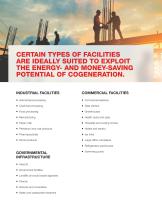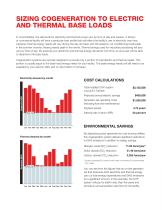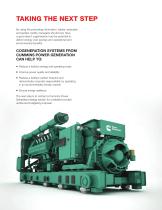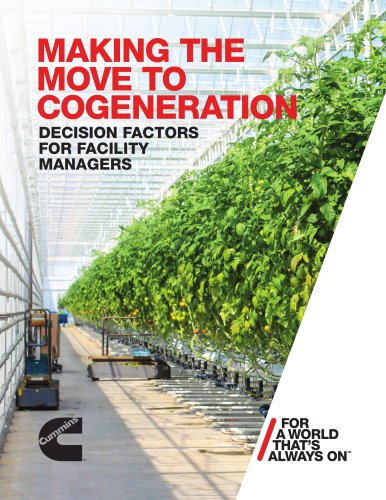
Catalog excerpts

MAKING THE MOVE TO COGENERATION DECISION FACTORS FOR FACILITY MANAGERS
Open the catalog to page 1
IS COGENERATION RIGHT FOR YOUR FACILITY? In theory, almost any facility with a simultaneous need for both electric and thermal energy is a potential candidate for the energy-saving benefits of cogeneration: on-site systems that produce electric power and thermal energy from a single source of fuel. Cogeneration projects can have both monetary and energy savings for a wide range of applications, but three key factors impact the economic and environmental savings that can be achieved through this type of project. These factors are as follows: WHY A FACILITY MANAGER SHOULD CONSIDER...
Open the catalog to page 2
CERTAIN TYPES OF FACILITIES ARE IDEALLY SUITED TO EXPLOIT THE ENERGY- AND MONEY-SAVING POTENTIAL OF COGENERATION. INDUSTRIAL FACILITIES COMMERCIAL FACILITIES Animal feed processing Commercial bakeries Chemical processing Data centers Food processing Health clubs and spas Paper mills Hospitals and nursing homes Petroleum and coal products Wood products Large office complexes Refrigerated warehouses GOVERNMENTAL INFRASTRUCTURE Swimming pools Airports Government facilities Landfills and solid waste digesters Prisons Schools and universities Water and wastewater treatment
Open the catalog to page 3
KEY FACTORS AFFECTING ECONOMIC VIABILITY 1. GAS-ELECTRICITY COST RATIO This ratio, also known as the “spark spread,” is equal to the local cost of electricity minus the local cost of natural gas on an equivalent kWh or MMBtu basis. Spark spread describes the financial leverage that occurs when one energy source is more economical than another. When the cost of electricity is high and the cost of natural gas is low in relative terms, facility managers can lower overall energy costs by displacing high electric utility costs with electricity generated on-site using natural gas. The larger this...
Open the catalog to page 4
FIGURING A SIMPLE PAYBACK If an end-user has sufficient baseload needs for both electric and thermal energy, the following information can be useful for determining a simple payback. The first step is to determine the total cost of electricity at the point of use. This total cost can be determined by the following formula: Total electric cost = [DC x MD x 121 + [EC x AE] AE DC = Monthly demand charges in $/kW MD = Monthly demand in kW EC = Average annual cost of energy in $/kWh AE = Annual electric use in kWh CHP Payback Calculator Fuel $/MMBtu Second, determine the end-user’s average cost...
Open the catalog to page 5
SIZING COGENERATION TO ELECTRIC AND THERMAL BASE LOADS In most facilities, the demands for electricity and thermal power vary by time of day and season. A factory or commercial facility will have a particular load profile that will reflect the facility’s use of electricity over time. Likewise, thermal energy needs will vary during the day and also with the seasons. Air conditioning loads peak in the summer months; heating needs peak in the winter. Thermal energy used for industrial processing will also vary by time of day. By tracking your electricity and thermal energy demands over time,...
Open the catalog to page 6
TAKING THE NEXT STEP By using the preceding information, tables, examples and guides, facility managers should now have a good idea if cogeneration has the potential to deliver energy cost savings and operational and environmental benefits. COGENERATION SYSTEMS FROM CUMMINS POWER GENERATION CAN HELP TO: Reduce a facility’s energy and operating costs Improve power quality and reliability Reduce a facility’s carbon footprint and demonstrate corporate responsibility by operating in an environmentally friendly manner Ensure energy resiliency The next step is to contact a Cummins Power...
Open the catalog to page 7
10 REASONS TO CHOOSE COGENERATION FROM CUMMINS POWER GENERATION 1. Significant energy savings and greater control of energy costs 2. Increased power reliability and business continuity for critical operations 3. Measurable results 4. Single-source manufacturer of engines, alternators and switchgear 5. Hands-off operations and maintenance with service agreements 6. Comprehensive, best-in-class performance warranties 7. Proven technology using Cummins lean-burn gas engines 8. High heat quality, high fuel efficiency and low emissions 9. Rising energy costs 10. Financial, environmental and...
Open the catalog to page 8All CUMMINS GENERATOR TECHNOLOGIES catalogs and technical brochures
-
KTA50 Powered Generator Set
8 Pages
-
2022 POWER GENERATION PRODUCTS
68 Pages
-
POWERCOMMAND®
12 Pages
-
POWERCOMMAND CLOUD™
9 Pages
-
QSK95 SERIES GENERATOR SETS
8 Pages
-
Generating insight edition 5
16 Pages
-
Generating Insight Edition 3
16 Pages
-
Generating insight Edition 4
16 Pages
Archived catalogs
-
AvK PRODUCT GUIDE
12 Pages
-
STAMFORD PRODUCT GUIDE
16 Pages


































